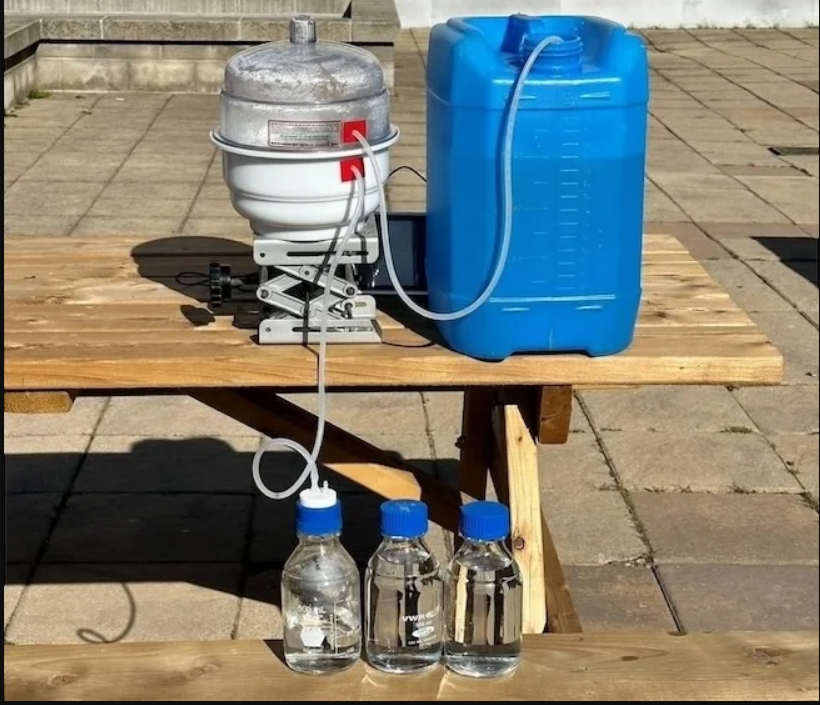In a world where access to clean water is becoming increasingly scarce, researchers at the University of Waterloo have developed an innovative solution that could quench the thirst of millions. Their new solar-powered desalination device offers a sustainable and efficient method to convert seawater into drinkable water, addressing a critical global need.
The United Nations World Water Development Report 2024 paints a stark picture: approximately 2.2 billion people worldwide lack access to clean water sources. This staggering figure underscores the urgent need for new technologies to generate fresh water, especially in coastal and island nations where water scarcity is a pressing concern.
How the Device Works
Dr. Michael Tam, a professor in Waterloo’s Department of Chemical Engineering, explains the inspiration behind their groundbreaking device: “Our inspiration comes from observing how nature sustains itself and the way water evaporates and condenses in the environment. The system we’ve engineered induces water to evaporate, transports it to the surface, and condenses it in a closed cycle, effectively preventing the accumulation of salt that reduces the efficiency of the device.”
The innovative approach taken by the Waterloo team sets their device apart from traditional desalination systems. Current methods often rely on pumping seawater through membranes to separate salt from water. However, these systems are energy-intensive and prone to operational issues. Salt buildup on the device’s surface frequently clogs the system, necessitating frequent maintenance and disrupting continuous operation.
In contrast, the new Waterloo device mimics the natural water cycle, specifically how trees transport water from their roots to their leaves. This biomimetic approach allows for continuous desalination without the need for major maintenance, solving one of the key challenges faced by existing technologies.
Similar Posts
Under the Hood
The heart of the system lies in its innovative materials. PhD students Eva Wang and Weinan Zhao, integral members of the research team, designed the device using nickel foam coated with a conductive polymer and thermoresponsive pollen particles. This unique combination of materials absorbs sunlight across the solar spectrum, efficiently converting it into heat.
The process works by heating a thin layer of seawater on the surface of the polymer. As the water evaporates, it moves upward, similar to the capillary action found in trees. Meanwhile, the remaining salt is carried down to the bottom layer of the device, effectively preventing blockages. This self-cleaning mechanism, reminiscent of a swimming pool’s backwash system, allows the device to run continuously without maintenance.
Focus on Sustainability
One of the most impressive aspects of this new technology is its energy efficiency. The device can convert about 93 per cent of sunlight into usable energy, making it five times more efficient than current desalination technologies. This high efficiency translates into practical output: the device can produce approximately 20 litres of fresh water per square meter every day. To put this into perspective, this volume meets the World Health Organisation’s recommended daily water requirement per person for basic drinking and hygiene needs.
Dr. Yuning Li, another professor from Waterloo’s Department of Chemical Engineering who contributed to the project, highlights the device’s versatility: “This new device is not only efficient but also portable, making it ideal for use in remote regions where access to fresh water is limited. This technology offers a sustainable solution to the emerging water crisis.”
The portability of the device is a crucial feature, especially for addressing water scarcity in remote and underserved areas. Its ability to operate effectively in locations with limited infrastructure opens up new possibilities for providing clean water to communities that have long struggled with this basic necessity.
The Way Forward
Looking ahead, the Waterloo researchers have ambitious plans to scale up their technology. They aim to build a larger prototype that can be deployed at sea, allowing them to test the device’s performance in real-world conditions. Dr. Tam expressed optimism about the potential impact of their work: “If the test is proven successful, the technology can sustainably supply fresh water to coastal communities and advance UN Sustainable Development Goals three, six, 10, and 12.”
The implications of this technology extend beyond just providing clean water. By harnessing solar energy and minimizing maintenance requirements, the device could significantly reduce the environmental impact and operational costs associated with desalination. This aligns well with global efforts to combat climate change and promote sustainable development.
The development of this solar-powered desalination device is part of a broader trend in renewable energy innovation. As the world grapples with the dual challenges of water scarcity and climate change, technologies that can address both issues simultaneously are increasingly valuable. Solar installations are growing globally, making significant contributions to clean energy production. The integration of solar power with water purification technologies represents a promising direction for sustainable resource management.
It’s worth noting that while this technology shows great promise, it’s still in the research and development phase. The next steps of building and testing a larger prototype will be crucial in determining its viability for widespread implementation. If successful, this could mark a significant step forward in making desalination more accessible and sustainable, particularly for coastal and island communities that are most affected by water scarcity.
The University of Waterloo’s solar-powered desalination device serves as an example of how innovative thinking and interdisciplinary research can lead to solutions for some of our most pressing global challenges. By drawing inspiration from nature and leveraging advanced materials science, the researchers have created a technology that could potentially transform how we approach water purification.
Into The Sun
As we look to the future, it’s clear that addressing global water scarcity will require a multifaceted approach. While technologies like this solar-powered desalination device play a crucial role, they are part of a larger picture that includes water conservation, improved infrastructure, and sustainable water management practices. The success of such innovations underscores the importance of continued investment in scientific research and development, particularly in areas that directly impact human wellbeing and environmental sustainability.
In conclusion, the solar-powered desalination device developed by the University of Waterloo researchers represents a promising step towards more sustainable and efficient water purification methods. As the world continues to face growing water scarcity challenges, innovations like this offer hope for a future where clean water is accessible to all, regardless of geographic location or economic status. The journey from laboratory breakthrough to widespread implementation may be long, but each advancement brings us closer to solving one of humanity’s most fundamental needs.








